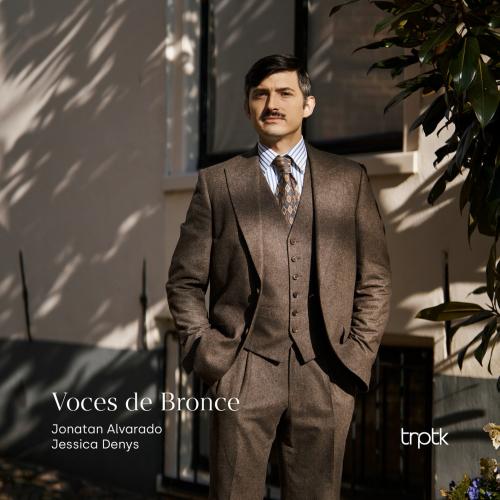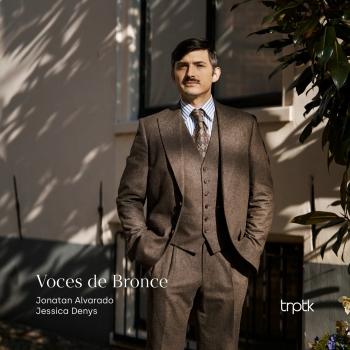
Voces de Bronce Jonatan Alvarado & Jessica Denys
Album info
Album-Release:
2023
HRA-Release:
28.04.2023
Album including Album cover Booklet (PDF)
- 1 Amargura ('El Floridense') 03:30
- 2 En vano, en vano...! 02:20
- 3 Estilo criollo, Op.8 No.4 02:06
- 4 Gorjeos ('La Mariposa') 03:51
- 5 Entre colores 02:21
- 6 Canción agreste ('El Milongón') 02:55
- 7 El pañuelo de seda 03:39
- 8 El alma del payador 02:43
- 9 El sueño 03:07
- 10 La vida del carretero 03:11
- 11 La cordobesa 02:22
- 12 Aires criollos No.2: I. La porteñita (Zamba) 01:04
- 13 Aires criollos No.2: II. Recuerdos (Estilo clásico) 02:00
- 14 Vidalita ('Flor Marchita') 04:09
- 15 Claveles mendocinos 03:05
- 16 Chinita linda 02:04
- 17 El Pericón 02:18
- 18 El gato 02:44
- 19 El triunfo 02:28
- 20 Un bailongo (Milonga) 03:20
- 21 Joaquina (Tango) 02:34
- 22 Mi noche triste (Tango-canción) 03:17
Info for Voces de Bronce
The first time I heard Carlos Gardel was in my maternal grandmother’s voice. She enjoyed singing, and used her beautiful, light soprano voice mostly to entertain herself while doing chores. From her I learned “Soledad”, one of Gardel’s most famous tangos which we kept calling “our song” throughout her life. On my father’s side, my grandparents were recognized tango dancers, a regular presence in the local and regional milongas and dance competitions. They heard every tango orchestra and singer worth their salt from the late 40’s to the 60’s, and, later in their lives, they would become members of different tango appreciation societies as the genre became less socially relevant.
Gardel was an unavoidable figure in my life, and the love of tango, one of the most valued parts of my family inheritance. I even became, at 8 years of age, the youngest audience member when the Mercedes Gardel Society hosted a projection of Gardel’s movie “Mi Buenos Aires Querido” in the local library. Yet my personal connection with Gardel and his tango has always been somewhat indirect: a profound but distant fascination but never an active engagement. The subjects of its lyrics, the music’s general spirit, and the sensibility which informs it has always seemed foreign to me. A sensation which the arbitrary distinction between the tango cosmopolitanism and the folklore’s rustic characterization – too prevalent even today in Argentina — would only deepen.
I felt as though I needed to choose between one or the other. I therefore decided on the music closest to my experience, which admittedly had little to do with amorous conquests or the existential anguish of the valiant Buenos Aires’ men. Eventually I moved to Europe and kept my musical heritage for myself while exploring those of the Iberian Middle Ages, as well as the Renaissance and Early Baroque periods of the Ibero-American empires. Through them I developed my own musical method to bring together historical sources into convincing musical performances.
My interests soon moved from just amassing musical pieces to researching the networks, institutions and communities that made their transmission and survival across the centuries possible. Most importantly, I was fascinated by the role played by subjective matters of taste in the transmission of certain repertoires between different communities, leading some composers to become legends, others to be forgotten. Soon I began to look back at my country’s own historical repertoire with the same curiosity, bringing me back to Gardel’s unavoidable figure. I was less interested in his tango legend but in the actual living historical figure and the undeniable role played by the communities and repertoires of the “canto criollo” which defined him as an artist.
Jessica Denys, vocals, guitar (Francisco Nuñez, Buenos Aires ca. 1910)
Jonatan Alvarado, guitar (Francisco Rebasti, Buenos Aires 1921)
Juan Vizán, vocals (tracks 7, 14)
Sophia Patsi, vocals (tracks 15, 19)
No biography found.
Booklet for Voces de Bronce










